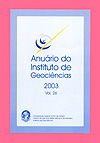Aplicações de técnicas geofísicas na parte emersa da Baía de Guanabara: uma revisão bibliográfica
DOI:
https://doi.org/10.11137/2003_0_117-126Resumo
Este trabalho apresenta a aplicação de técnicas geofísicas em duas investigações realizadas no entorno da baía de Guanabara, Rio de Janeiro. A primeira foi executada na área da Petroflex, uma indústria petroquímica situada na região de Campos Elíseos às margens da baía e a segunda na Ilha do Fundão localizada dentro da mesma. Segundo Anjos et al..(2001) a pesquisa na Petroflex foi parte de um projeto social desta companhia chamado: "Conheça seu Manguezal". Para este estudo a pesquisa geofísica foi realizada dentro do parque industrial a fim de identificar contaminação de lixo sólido (borracha, plástico e latão metálico). Foi usada a técnica do Ground Penetrating Radar (GPR) com o equipamento RAMAC/MALA. Na área de estudo são encontradas argila e areia, depositadas em condições marinhas as quais são freqüentemente contaminadas por água salgada. Em geral, os resultados obtidos com o GPR para argilas e sedimentos saturados em água não são satisfatórios. Entretanto, na área da Petroflex os resultados foram bons. A seqüência estratigráfica na área é a seguinte, do topo para a base: A camada mais superior é um depósito de argila, a segunda camada é formada de argila marinha escura e a terceira camada é composta de areia de grãos finos com conchas marinhas . A interpretação das linhas de GPR com profundidade média de 14 m e velocidade média de 70m/µs, mostrou duas descontinuidades físicas dentro da segunda camada (argila marinha) a qual possivelmente representa a exposição da plataforma no Pleistoceno, descrita na literatura como Regression Guanabariana. Foi possível identificar também anomalias dentro da primeira camada (depósito de argila), representada por um sinal atenuado e outras identificadas como tambores com resíduos sólidos. Este trabalho mostrou um exemplo de sucesso da aplicação do GPR em locais argilosos com presença de água salgada. A Ilha do Fundão, local da segunda investigação, segundo Rocha et al.. (1998) foi formada por um aterro artificial em um arquipélago formado por pequenas ilhas construído nos anos de 1950. O objetivo da investigação foi identificar por meio de uma pesquisa geoelétrica os núcleos originais das ilhas. Normalmente, estruturas próximas de regiões costeiras não podem ser detectadas devido à presença de água salgada nos sedimentos. Entretanto no caso da Ilha do Fundão os sedimentos eletricamente condutivos têm uma forma lenticular de pouca espessura correspondendo ao aterro. Essa geometria permitiu a detecção dos núcleos resistivos os quais são as ilha originais do arquipélago. Tais conclusões foram baseadas nos resultados da sondagem elétrica usando a configuração de Schlumberger com a abertura máxima (ab/2) de 100 ms. Os dados originais foram publicadosem Rocha et al.(1998).Downloads
Não há dados estatísticos.
Downloads
Publicado
2003-01-01
Como Citar
Rocha, P. L. F. da (2003) “Aplicações de técnicas geofísicas na parte emersa da Baía de Guanabara: uma revisão bibliográfica”, Anuário do Instituto de Geociências. Rio de Janeiro, BR, 26, p. 117–126. doi: 10.11137/2003_0_117-126.
Edição
Seção
Artigos
Licença
Os artigos publicados nesta revista se encontram sob a llicença Creative Commons — Atribuição 4.0 Internacional — CC BY 4.0, que permite o uso, distribuição e reprodução em qualquer meio, contanto que o trabalho original seja devidamente citado.
















 Exceto onde indicado de outra forma, o conteúdo deste site é licenciado sob uma licença
Exceto onde indicado de outra forma, o conteúdo deste site é licenciado sob uma licença 